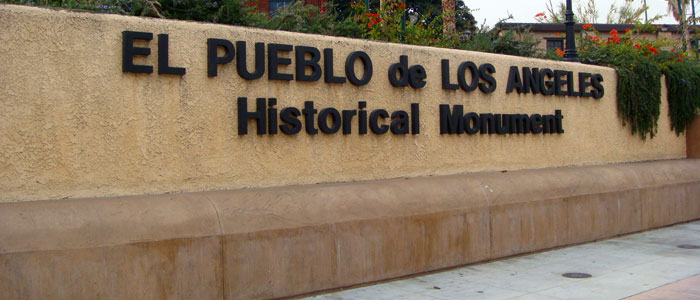Los Angeles, California Travel Guide
About Know the Neighborhoods Getting Around Attractions Hotels
Eats & Nightlife Essentials & Practicals
Olvera Street

El Pueblo De Los Angeles Historical Monument at Olvera Street
The overview of Olvera Street is below. I’ve also created the Olvera Street and LA Historic Buildings directory.
Overview: El Pueblo De Los Angeles Historical Monument. No other place in Los Angeles is as steeped in the history and culture of Los Angeles as Olvera Street. Known as El Pueblo, or “The Town,” Olvera Street and the adjoining Olvera Old Plaza, have the unique distinction of being the site of the oldest part of Los Angeles. Consequently, Olvera Street and Old Plaza are recognized together as the El Pueblo de Los Angeles Historical Monument, The Town Monument, as the small area of Olvera is where Los Angeles started. The street and plaza constitute the surrounding 44 acre El Pueblo park.

El Pueblo De Los Angeles Historical Monument
This historic “pueblo” is just north of the 110 Freeway and is located at E Cesar E Chavez Ave and N Alameda St. It was originally traversed and founded by 44 settlers in September 1781. After being under Spanish and Mexican rule, Los Angeles finally established itself as a county of California. Today, Olvera Street and Old Plaza are truly a celebration of Los Angeles and they host numerous large-scaled events such as the Los Angeles Mardi Gras (yes, Los Angeles has a Mardi Gras!), Cinco de Mayo, Chinese Lantern Festival and a slew of others.

The Firehouse Musuem at Olvera Street
Olvera Street is adjacent to Olvera Old Plaza. Olvera Street is a narrow lane bustling with color marketplace vendors selling anything from belts to clothing to guitars and crafts. The aroma pervading Olvera Street comes from all the authentic cafes and food vendors, including the famous La Golondrina Cafe the oldest restaurant on Olvera Street and housed in the Pelaconi House, the oldest brick house in Los Angeles. But, the distinction of the “oldest house” in Los Angeles goes to Avila Adobe, directly on Olvera Street. The other historic building is the Sepulveda House, one of the greatest Victorian Eastlake architectural feats that combines commercial and residential uses. Olvera Street is lined with vendors in the middle of the street as well as on the sides. It does get a bit crowded but nothing in Los Angeles comes close to the atmosphere, history and culture like Olvera Street.

Pico House at Olvera Street
The short Olvera Street leads into the Old Plaza, the flat brick-laiden, courtyard of El Pueblo at the south end. The Old Plaza is comprised of food and souvenir vendors, a central, elevated bandstand where you will find statues King Carlos III of Spain and Felipe de Neve, live performances, fiestas and the Founders Plaque, listing the 44 founders of Los Angeles. Throughout the day, the bandstand is filled with live performances that range from dancers representing history and culture to music bands. In the surrounding plaza are other historic buildings – there are 27 historic buildings altogether that make El Pueblo’s history – including the Firehouse Museum, which is the first fire fighter house in Los Angeles, the Garnier Building, the oldest Chinese building in California, the Pico House, the first hotel and three story building in Los Angeles and the Plaza Methodist Church.

Vendors and markets at Olvera Street
In addition to the historic buildings, you will find tucked away in the Olvera Old Plaza, the fascinating Chinese American Museum. Amazingly, Olvera Street and Old Plaza packs nearly 80 shops and vendors in the small area.
Grab a churro from one of the vendors, a fruit drink and celebrate the festive Olvera Street, a true gem which gave to the City of Angels.
Click for Olvera Street and L.A. Historical Buildings Directory.
Contact: 845 N. Alameda Street, Los Angeles, CA 90012
Site: www.olvera-street.com and www.cityofla.org/ELP/
Email: info@olvera-street.com
Ph: (213) 680-2525
Cost: Free to visit, even the Adobe House.
Parking: There are a few parking options but the easiest option is to park at the Post Office Annex at the corner of northeast corner of Cesar Chavez and Alameda.
Accessibility: Olvera Street and Olvera Plaza are wheelchair accessible.
Getting There: From the north, the Metro Red Line subway. From west, Santa Monica 10 bus, Metro Rapid 704. From the east, the Metro Gold Line